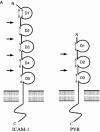Evolution of cell recognition by viruses: a source of biological novelty with medical implications
- PMID: 14719364
- PMCID: PMC7119103
- DOI: 10.1016/s0065-3527(03)62002-6
Evolution of cell recognition by viruses: a source of biological novelty with medical implications
Abstract
The picture beginning to form from genome analyses of viruses, unicellular organisms, and multicellular organisms is that viruses have shared functional modules with cells. A process of coevolution has probably involved exchanges of genetic information between cells and viruses for long evolutionary periods. From this point of view present-day viruses show flexibility in receptor usage and a capacity to alter through mutation their receptor recognition specificity. It is possible that for the complex DNA viruses, due to a likely limited tolerance to generalized high mutation rates, modifications in receptor specificity will be less frequent than for RNA viruses, albeit with similar biological consequences once they occur. It is found that different receptors, or allelic forms of one receptor, may be used with different efficiency and receptor affinities are probably modified by mutation and selection. Receptor abundance and its affinity for a virus may modulate not only the efficiency of infection, but also the capacity of the virus to diffuse toward other sites of the organism. The chapter concludes that receptors may be shared by different, unrelated viruses and that one virus may use several receptors and may expand its receptor specificity in ways that, at present, are largely unpredictable.
Figures






Similar articles
-
Evolution of cell recognition by viruses.Science. 2001 May 11;292(5519):1102-5. doi: 10.1126/science.1058613. Science. 2001. PMID: 11352064 Review.
-
Virus dynamics and evolution: bridging scales and disciplines.Viruses. 2011 Aug;3(8):1432-8. doi: 10.3390/v3081432. Epub 2011 Aug 16. Viruses. 2011. PMID: 21994789 Free PMC article. No abstract available.
-
Molecular mechanisms of virus spread and virion components as tools of virulence. A review.Acta Microbiol Immunol Hung. 2003;50(4):407-31. doi: 10.1556/AMicr.50.2003.4.8. Acta Microbiol Immunol Hung. 2003. PMID: 14750441 Review.
-
Editorial overview: viral evolution: exploring the frontiers of virus evolution in the lab, the field and the clinic.Curr Opin Virol. 2014 Oct;8:ix-x. doi: 10.1016/j.coviro.2014.09.002. Epub 2014 Sep 13. Curr Opin Virol. 2014. PMID: 25224393 No abstract available.
-
Toll like receptors and viruses.Rev Med Virol. 2007 Jan-Feb;17(1):35-43. doi: 10.1002/rmv.525. Rev Med Virol. 2007. PMID: 17146842 Review.
Cited by
-
Virus is a Signal for the Host Cell.Biosemiotics. 2015;8(3):483-491. doi: 10.1007/s12304-015-9245-0. Epub 2015 Jul 17. Biosemiotics. 2015. PMID: 26640606 Free PMC article.
-
Guinea pig-adapted foot-and-mouth disease virus with altered receptor recognition can productively infect a natural host.J Virol. 2007 Aug;81(16):8497-506. doi: 10.1128/JVI.00340-07. Epub 2007 May 23. J Virol. 2007. PMID: 17522230 Free PMC article.
-
Microarray-based identification of antigenic variants of foot-and-mouth disease virus: a bioinformatics quality assessment.BMC Genomics. 2006 May 18;7:117. doi: 10.1186/1471-2164-7-117. BMC Genomics. 2006. PMID: 16709242 Free PMC article.
-
SARS-CoV-2 Point Mutation and Deletion Spectra and Their Association with Different Disease Outcomes.Microbiol Spectr. 2022 Apr 27;10(2):e0022122. doi: 10.1128/spectrum.00221-22. Epub 2022 Mar 29. Microbiol Spectr. 2022. PMID: 35348367 Free PMC article.
-
Frequency and fitness consequences of bacteriophage φ6 host range mutations.PLoS One. 2014 Nov 19;9(11):e113078. doi: 10.1371/journal.pone.0113078. eCollection 2014. PLoS One. 2014. PMID: 25409341 Free PMC article.
References
-
- Aderem A, Underhill D.M. Mechanisms of phagocytosis in macrophages. Annu. Rev. Immunol. 1999;17:593–623. - PubMed
-
- Agace W.W, Amara A, Roberts A.I, Pablos J.L, Thelen S, Uguccioni M, Li X.Y, Marsal J, Arenzana-Seisdedos F, Delaunay T, Ebert E.C, Moser B, Parker C.M. Constitutive expression of stromal derived factor-1 by mucosal epithelia and its role in HIV transmission and propagation. Curr. Biol. 2000;10(6):325–328. - PubMed
Publication types
MeSH terms
Substances
LinkOut - more resources
Full Text Sources

